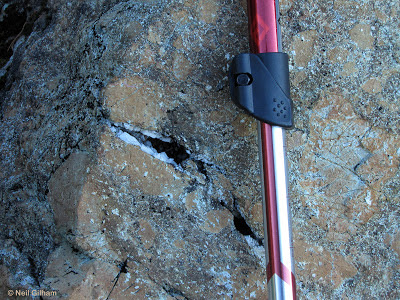The field trip was led by Dave Tucker, a director of the nonprofit Mount Baker Volcano Research Center and long time researcher of volcanic stratigraphy in the North Cascades with an obvious focus on the Mount Baker area. I had been on several field trips with Dave, adding more to my knowledge base of North Cascades geology while discovering new places. The field trip group consisted of a couple family groups and a few interested individuals like me. We all met at the Glacier Public Service Center in Glacier, then bussed up from there to the trailhead at Artist Point.
The Ptarmigan Ridge trail is fairly level with a few gentle ups and downs. For the first mile, the trail skirts the southern side of Table Mountain, offering unending views of Mount Shuksan, the subject of countless picture calendars. Laid out below was virtually the entire scope of the Kulshan caldera, evidenced most by the white-colored ignimbrite exposed in gullies cut by the various streams that eventually coalesce into Swift Creek. The ignimbrite is the lithified volcanic ash that filled the caldera to over a 1,000 meters deep.
We made several stops along the hike to learn new things. Rocks of the Chilliwack Group at 200 million years old were the oldest rocks we would see. The Chilliwack Group represents oceanic island volcanic and sedimentary rocks brought in by plate movement as the Pacific Plate and North American plates collided, with the more dense Pacific plate diving underneath the North American plate, leaving behind and attaching the Chilliwack Group rocks onto the margin of the North American plate. Picture a conveyor belt and you get the idea. The Chilliwack Group rocks viewed here were a volcanic breccia of a beautiful shade of butterscotch cut with quartz crystal-filled fractures.
Most of the trail is on two andesite lava flows, the Table Mountain andesite lava (301 to 309 thousand years old) that sandwiches the Coleman Pinnacle andesite lava flow (305 thousand years old). The the Coleman Pinnacle andesite differentiates itself with black hornblende crystals encased in the gray aphanitic matrix. Along the way we observed polished and striated surfaces left from the passage of glaciers since melted away.
It was an absolute gorgeous day with barely a cloud in the sky, except a few wispy clouds on Baker's summit that later in the day developed into a full double-lenticular hat. A faunal highlight was a mountain goat laying on a distant snowfield enjoying the sun.
Now a few photos.
The morning start offered full, in-your-face views of Mount Baker.
Detail of a volcanic breccia of the 200-million year old Chilliwack Group.
The Swift Creek ignimbrite (white), a lithified volcanic ash that filled the post-eruption Kulshan caldera 1.15 million years ago.
Glacial polish and striations on an andesite lava flow.
At 3 miles in, this is as close as we got to glacier-shrouded Mount Baker. Coleman Pinnacle is the closer peak. Backcountry skiers were making a few short runs on the sun-cupped tongues of snow below Coleman Pinnacle.
Mountain goat chillax.
Looking the way we came, into the North Cascades all the way into British Columbia.
The Mount Shuksan calendar shot. Note the exposures of Swift Creek ignimbrite in the gulleys below the mountain. Kulshan caldera includes just about the entire area seen below tree line.
On the way out looking back, Mount Baker grew a lenticular cloud hat.
Near the end of the road at Artist Point is this incredible contorted columnar andesite.
The route (adapted from http://www.gmap-pedometer.com/).











No comments:
Post a Comment